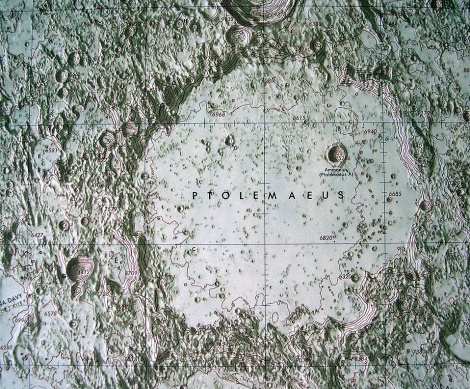March 4, 2004
Ptolemaeus Peak Heights
Image Credit: NASA Chart LM 77 |
|
Ptolemaeus Peak Heights
Lunar observers, long impressed by lengthy shadows of peaks, have often
speculated on the their heights. Galileo used shadow lengths to estimate peaks heights, and Schroter, Madler
and especially Schmidt determined a few thousand peak heights and crater depths this way. Shadow measurements at
the telescope require great care, and are susceptible to systematic error. As part of my job in the early 1970s
of directing the daily work of cataloging the Moon with Lunar Orbiter photos I also measured many shadows.
Similar techniques (but mechanized) of measuring feature positions on Apollo 16 Metric stereo photographs were
used by the US Defense Mapping Agency to produce maps with 300 m contours. This excerpt from map LM 77 -
Ptolemaeus (1:1m; 1978) shows the same area as in yesterday's LPOD. A larger,
unmarked version can be seen by clicking on this image. Now, with these contours and spot heights we can determine
more accurately than ever before the heights of peaks rimming Ptolemaeus. Accepting 6900 m (relative to the
average radius of the Moon) as the average level of the relatively flat floor of Ptolemaeus I have determined the
following peak heights above that floor:
Related Links: Tomorrow's LPOD: What's All The Excitement About Mars? |
|
Author & Editor: Technical Consultant: A service of: |
COMMENTS?
Register, and click on the Discussion tab at the top of the page.




